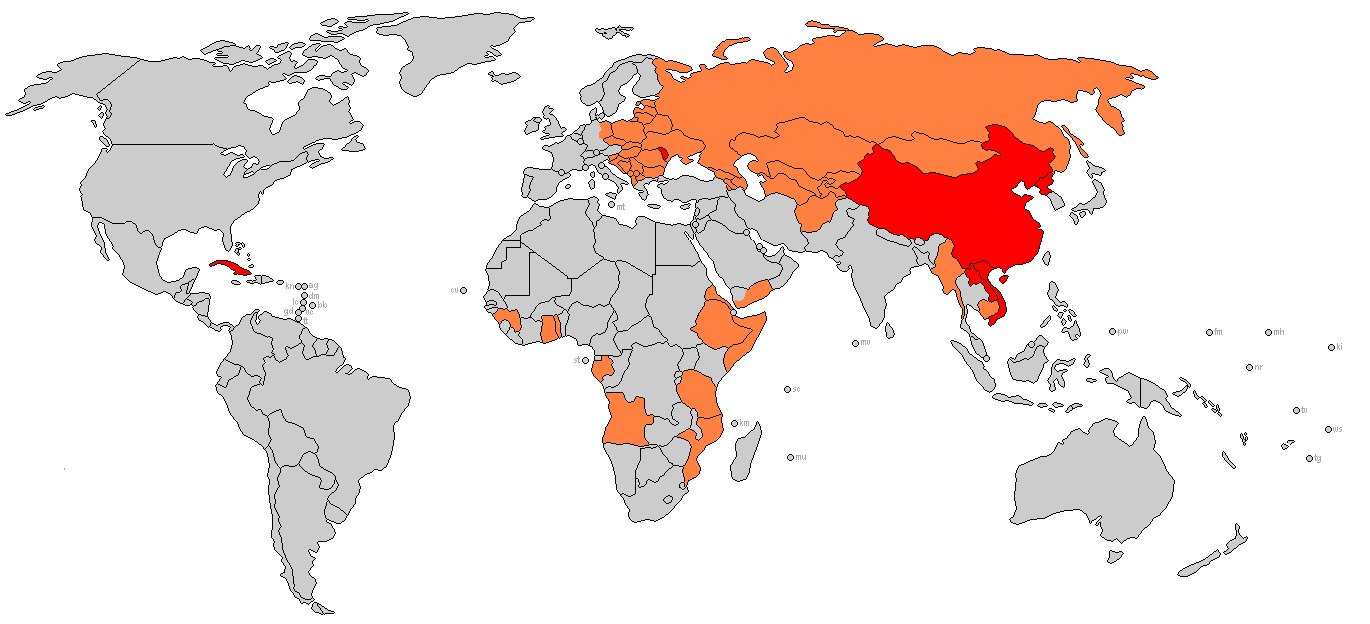The division of the world into the first (capitalistic) world and the second (communistic) one for decades seemed very stable. If anything, Communism was often supposed – and even more often advertised – to be more efficient. Western economists were estimating when the second world will surpass the first one.
Download full article:
TOMASZ KASPROWICZ 30 YEARS OF FREEDOM IN CEE VARIOUS PATHS
In 1961, Nobel Prize winner Paul Samuelson predicted that the Soviet Union would have higher per capita product than the United States sometime between 1998-19971 and he maintained his forecast up to 1980, pushing the nefarious moment to between 2002 and 2012.
Luckily, Nobel Prize winners tend to be very wrong in their anticipations and around 1989 the Communist Block collapsed – mainly due to economic reasons. This turn of events opened a new path to many nations, which were formerly under Soviet rule.
Figure 1: Abandoning communism in the world in 2019 [orange – former communist countries; red –communist countries]
 Source: Sjorskingma // CC BY-SA 3.0
Source: Sjorskingma // CC BY-SA 3.0
The Landscape
Former socialist countries span most of the Asian continent, and a good part of Africa and Europe [See: Figure 1]. After the collapse, Communism became almost extinct – with the notable exception of China and its satellites. It is hard, however, to call China communist anymore – especially when it comes to the economy.
Let us, therefore, take a look into the European post-Soviet countries, as well as the Asian ones that appeared after the deconstruction of the USSR.
It is important to understand that for most of the countries, the transformation was a complete overhaul of politics, economics, and mentality. In fact, it was a true reemergence after decades of oblivion – and for many, the first shot at independence.
The cases of Poland, Bulgaria, Romania, or Hungary, which remained in the same shape and ‘just’ had to change the political and economic regime, were exceptions. It was a turbulent time when countries split. Sometimes it was surprisingly peaceful and efficient – as in the case of Czechoslovakia, which was divided into the Czech Republic and Slovakia.
However, this was not always the case. One notable example would be Yugoslavia. There, the decomposition resulted in bloodshed that lasted five years, with “follow ups” – Kosovo and Macedonia – leading to almost a decade of genocide, ethnic cleansing, and a total of 140,000 deaths2.
Yet, such events were not localized to the Balkans and we need to remember about other conflicts – like the one between Azerbaijan and Armenia, which caused the deaths of over 17,000 people and further displacement of another 750,0003. Even up to today, it is reported that there are approximately 200 sniper casualties per year, despite the cease-fire that was signed in May 1994.
The time when nations could decide to go their own way did not last long. Russia quickly decided to stop further decomposition of its empire. One way was tying newly formed countries of ‘near abroad’ in international organizations like the Commonwealth of Independent States or the Eurasian Economic Community. Also, an initially peaceful breakup became far more violent.
DOWNLOAD FULL ISSUE (PDF):
Single Page Spread
1 Samuelson, P. A. and A. Scott (1961) Economics: An Introductory Analysis, New York: McGraw-Hill.
2 International Center for Transitional Justice (2009) Transitional Justice in the Former Yugoslavia, January 1.
3 Popescu, N. (2010) EU Foreign Policy and Post-Soviet Conflicts: Stealth Intervention, London: Routledge.



